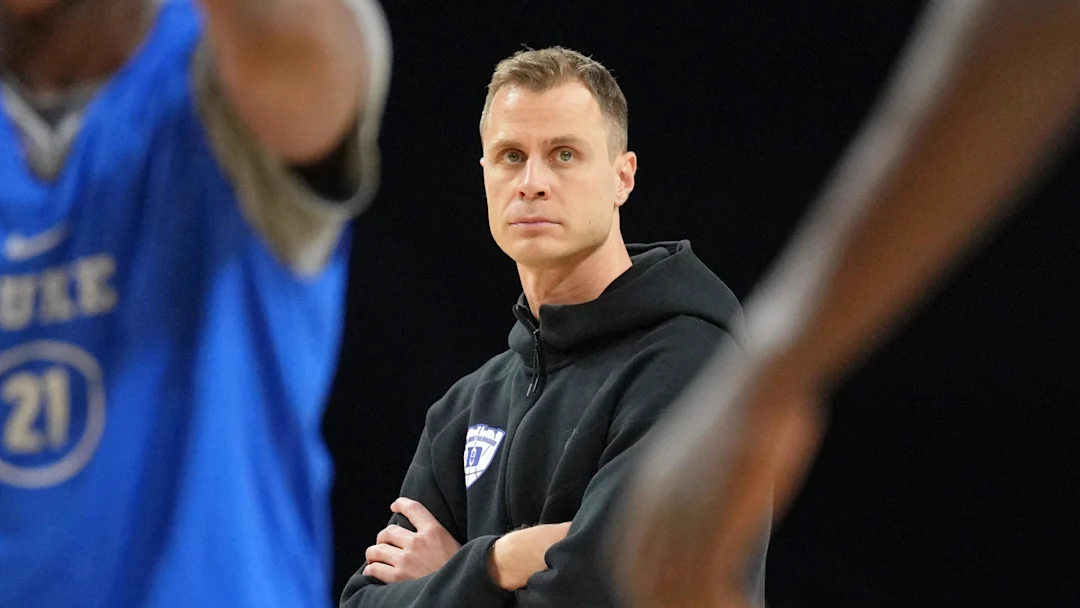Duke basketball, a program that has become synonymous with high expectations, elite recruits, and an ever-evolving roster, faces a unique challenge heading into the 2025 season. The Blue Devils’ plans for the upcoming year are in serious limbo, all thanks to one player: Cedric Coward. A highly anticipated talent in the world of college basketball, Coward’s decision on whether to stay or leave the program is poised to be a game-changer for Coach Jon Scheyer’s squad.
Coward’s journey to this point has been nothing short of intriguing. The 6-foot-9 forward from Baltimore, Maryland, entered Duke as one of the top recruits in his class. A versatile player known for his athleticism, defense, and ability to stretch the floor, Coward quickly became a centerpiece of the Blue Devils’ future. He was expected to make an immediate impact, bringing much-needed depth and versatility to a roster that boasted a mix of young stars and experienced players.
However, the reality of college basketball is that even the brightest prospects aren’t guaranteed to have smooth sailing. Coward, despite flashes of brilliance in his freshman year, has experienced growing pains—both on the court and off it. Like many freshmen adjusting to the rigors of college athletics, he faced the typical struggles of consistency, adapting to the speed of the game, and finding his place within Duke’s complex offensive and defensive systems.
Despite these challenges, Coward’s potential remained undeniable. His length and athleticism made him a tough matchup for opposing defenses, and his ability to defend multiple positions provided Duke with an added layer of flexibility. Yet, there remained a lingering sense of uncertainty about his future in Durham. While many expected him to take the next step in his development, the question remained: would he choose to return for another season, or would he leave the program early?
As the 2025 season approached, the decision loomed larger than ever. Coward’s performance during the offseason and preseason practices seemed to indicate he had made significant strides in his game. His ability to hit outside shots, move fluidly on the defensive end, and create opportunities for his teammates was improving. However, the mental aspect of his game, particularly his comfort level within the system, was still a work in progress. This led to some mixed reviews from coaches and analysts, who praised his potential but wondered if he was ready to take on a more prominent role with the Blue Devils.
The tipping point came when Coward announced that he would take some time before making his final decision. The ambiguity surrounding his status sent shockwaves through the Duke basketball community. A player of Coward’s caliber is not someone you expect to keep the program in suspense. His decision would undoubtedly have a ripple effect on the team’s roster and its prospects for the 2025 season.
For Coach Jon Scheyer and the Blue Devils, Coward’s indecision created a significant challenge. With Duke’s recruiting class already established and a core group of players returning, the team was in the midst of shaping its identity for the upcoming season. But Coward’s situation made it difficult to finalize the rotation and make long-term plans. If he returned, the Blue Devils would have a talented forward who could complement their already stacked roster. However, if Coward chose to leave, Duke would have to scramble to fill the void left by a player who, despite his inconsistency, brought a unique skill set to the table.
The uncertainty surrounding Coward’s future also created some tension within the locker room. Veteran players who were looking to make a deep run in the NCAA Tournament relied on the stability of the team’s roster. A late departure or unexpected shift in personnel could throw off the chemistry that had been cultivated over the summer and preseason. Additionally, the coaching staff had to carefully balance their efforts in recruiting and developing talent, knowing that Coward’s decision could either solidify the roster or force them to make last-minute adjustments.
This situation is not unique to Duke. In the high-stakes world of college basketball, players often have to make difficult decisions about their futures. Whether it’s weighing the option of entering the NBA Draft, transferring to another school, or returning for another season, the pressure to make the right choice can be overwhelming. However, for a program like Duke, which has a long history of success, the stakes are even higher. Every decision, big or small, carries significant weight in determining the direction of the program.
The fact that Coward’s decision is taking longer than expected only amplifies the pressure. Duke fans, players, and coaches alike are left to speculate on what the future holds. Will Coward embrace the challenge of returning for another year and cement his place in the Blue Devils’ storied legacy? Or will he choose to leave, either to pursue a professional career or explore other opportunities elsewhere? Only time will tell.
While some might see Coward’s indecision as a sign of uncertainty or doubt, it’s important to recognize that his situation reflects the complexities of modern college basketball. Players today have more options than ever before, with the rise of the transfer portal and the growing influence of NIL deals. These factors have made it increasingly difficult for players to commit fully to one program or make decisions with long-term consequences without carefully weighing all the available options.
For Duke, the uncertainty surrounding Coward’s future is a reminder of how quickly things can change in the world of college basketball. The Blue Devils have always prided themselves on their ability to attract top-tier talent and build championship-caliber teams. However, in today’s landscape, even the most successful programs must navigate an environment filled with unexpected twists and turns. One player’s decision, whether it’s Cedric Coward’s or someone else’s, can alter the trajectory of an entire season.
At this point, the ball is in Coward’s court. His decision will not only affect his future but also the future of Duke basketball. If he returns, the Blue Devils could have a potent lineup capable of making a serious run at the ACC title and beyond. However, if he leaves, the program will need to regroup and adjust its plans accordingly. For Coach Scheyer, the uncertainty surrounding Coward is a challenge, but one he’s likely prepared to face. After all, Duke has faced adversity before, and with the talent they have, they can weather any storm.
In the end, Cedric Coward’s decision is more than just about his future—it’s about the future of Duke basketball. His choice will reverberate through the program, impacting everything from the roster composition to the team’s championship aspirations. As the Blue Devils wait for Coward’s final call, they can only hope that the pause he’s pressing won’t be a setback but rather an opportunity for growth and success in the coming season.



